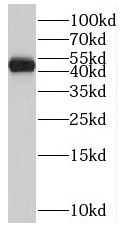Products
CCN3 antibody
| Synonyms: | CCN family member 3|Cellular communication network factor 3|Insulin-like growth factor-binding protein 9 (IBP-9 antibody, IGF-binding protein 9 antibody, IGFBP-9)|Nephro blastoma-overexpressed gene protein homolog|Protein NOV homolog (NovH)|CCN3|IGFBP9|NOV|NOVH antibody | ||
| Catalogue No.: | FNab05801 | Reactivity: | Human, Mouse, Rat |
| Host: | Rabbit | Tested Application: | ELISA, WB, IHC |
| Clonality: | polyclonal | Isotype: | IgG |
| Size | Price |
|---|---|
| 100µg | Inquiry |
- SPECIFICATIONS
- FIGURES
- CONDITIONS
- FAQS
- Product Name
- CCN3 antibody
- Catalogue No.
- FNab05801
- Size
- 100μg
- Form
- liquid
- Purification
- Immunogen affinity purified
- Purity
- ≥95% as determined by SDS-PAGE
- Clonality
- polyclonal
- Isotype
- IgG
- Storage
- PBS with 0.02% sodium azide and 50% glycerol pH 7.3, -20℃ for 12 months(Avoid repeated freeze / thaw cycles.)
- Immunogen
- nephroblastoma overexpressed gene
- Alternative Names
- CCN family member 3|Cellular communication network factor 3|Insulin-like growth factor-binding protein 9 (IBP-9 antibody, IGF-binding protein 9 antibody, IGFBP-9)|Nephro blastoma-overexpressed gene protein homolog|Protein NOV homolog (NovH)|CCN3|IGFBP9|NOV|NOVH antibody
- UniProt ID
- P48745
- Observed MW
- 45 kDa
- Tested Applications
- ELISA, WB, IHC
- Recommended dilution
- WB: 1:500-1:2000; IHC: 1:20-1:200
 mouse liver tissue were subjected to SDS PAGE followed by western blot with FNab05801(NOV antibody) at dilution of 1:500
mouse liver tissue were subjected to SDS PAGE followed by western blot with FNab05801(NOV antibody) at dilution of 1:500
 Immunohistochemistry of paraffin-embedded human nephroblastoma using FNab05801(NOV antibody) at dilution of 1:50
Immunohistochemistry of paraffin-embedded human nephroblastoma using FNab05801(NOV antibody) at dilution of 1:50
- Background
- Immediate-early protein playing a role in various cellular processes including proliferation, adhesion, migration, differentiation and survival(PubMed:15181016, PubMed:15611078, PubMed:12695522, PubMed:21344378, PubMed:12050162). Acts by binding to integrins or membrane receptors such as NOTCH1(PubMed:12695522, PubMed:21344378, PubMed:15611078). Essential regulator of hematopoietic stem and progenitor cell function(PubMed:17463287). Inhibits myogenic differentiation through the activation of Notch-signaling pathway(PubMed:12050162). Inhibits vascular smooth muscle cells proliferation by increasing expression of cell-cycle regulators such as CDKN2B or CDKN1A independently of TGFB1 signaling(PubMed:20139355). Ligand of integrins ITGAV:ITGB3 and ITGA5:ITGB1, acts directly upon endothelial cells to stimulate pro-angiogenic activities and induces angiogenesis. In endothelial cells, supports cell adhesion, induces directed cell migration(chemotaxis) and promotes cell survival(PubMed:12695522). Plays also a role in cutaneous wound healing acting as integrin receptor ligand. Supports skin fibroblast adhesion through ITGA5:ITGB1 and ITGA6:ITGB1 and induces fibroblast chemotaxis through ITGAV:ITGB5. Seems to enhance bFGF-induced DNA synthesis in fibroblasts(PubMed:15611078). Involved in bone regeneration as a negative regulator(By similarity). Enhances the articular chondrocytic phenotype, whereas it repressed the one representing endochondral ossification(PubMed:21871891). Impairs pancreatic beta-cell function, inhibits beta-cell proliferation and insulin secretion(By similarity). Plays a role as negative regulator of endothelial pro-inflammatory activation reducing monocyte adhesion, its anti-inflammatory effects occur secondary to the inhibition of NF-kappaB signaling pathway(PubMed:21063504). Contributes to the control and coordination of inflammatory processes in atherosclerosis(By similarity). Attenuates inflammatory pain through regulation of IL1B-and TNF-induced MMP9, MMP2 and CCL2 expression. Inhibits MMP9 expression through ITGB1 engagement(PubMed:21871891).
How many times can antibodies be recycled?
First, usually it's not suggested to recycle antibodies. After use, buffer system of antibodies has changed. The storage condition of recycled antibodies for different customers also varies. Thus, the performance efficiency of recycled antibodies can’t be guaranteed. Besides, FineTest ever conducted the antibody recycling assay. Assay results show recycling times of different antibodies also varies. Usually, higher antibody titer allows more repeated use. Customers can determine based on experimental requirements.
Notes: After incubation, we recycle rest antibodies to centrifuge tube and store at 4℃. High titer antibodies can be stored for a minimum of one week. Reuse about three times.
What are components of FineTest antibody buffer?
Components of FineTest antibody buffer are usually PBS with proclin300 or sodium azide, BSA, 50% glycerol. Common preservative is proclin300 or sodium azide, which is widely applied in the lab and industry.
How about the storage temperature and duration of FineTest antibodies?
Most antibodies are stored at -20℃. Directly-labeled flow cytometry antibodies should be stored at 2 - 8℃. The shelf life is one year. If after sales issues for purchased antibodies appear, return or replacement is available. Usually, antibodies can be still used after the one-year warranty. We can offer technical support services.
Is dilution required for FineTest antibodies? What’s the dilute solution?
Directly-labeled flow cytometry antibodies are ready-to-use without dilution. Other antibodies are usually concentrated. Follow the dilution ratio suggested in the manual. Dilute solution for different experiments also varies. Common antibody dilution buffers are acceptable(e.g. PBST, TBST, antibody blocking buffer).
How to retrieve antibodies for immunohistochemistry?
Common retrieval buffers: Tris-EDTA Buffer(pH 9.0); Citrate Buffer(pH 6.0)
Heat induced antibody retrieval:
Method 1: Water-bath heating: Put the beaker with retrieval buffer and slide in the boiling water bath. Keep the boiling state for 15min. Naturally cool to room temperature;
Method 2: Microwave retrieval: Put the beaker with retrieval buffer and slide in the microwave oven. Heat at high power for 5min, Switch OFF for 3min, Heat at medium power for 5min. Naturally cool to room temperature.
How to choose secondary antibodies?
(1) Secondary antibodies react with primary antibodies. Thus, secondary antibodies should be against host species of primary antibodies. E.g. If the primary antibody is derived from rabbit, the relevant secondary antibody should be against rabbit. E.g. goat anti rabbit or donkey anti rabbit.
(2) Choose secondary antibody conjugates according to the experimental type, e.g. ELISA, WB, IHC etc. Common enzyme conjugated secondary antibodies are labelled by HRP, AP etc. Fluorescin or dye labelled secondary antibodies are applied in immunofluorescence and flow cytometry(e.g. FITC, Cy3).
